Larose Family History & Genealogy
Larose Last Name History & Origin
AddHistory
We don't have any information on the history of the Larose name. Have information to share?
Name Origin
We don't have any information on the origins of the Larose name. Have information to share?
Spellings & Pronunciations
We don't have any alternate spellings or pronunciation information on the Larose name. Have information to share?
Nationality & Ethnicity
We don't have any information on the nationality / ethnicity of the Larose name. Have information to share?
Famous People named Larose
Are there famous people from the Larose family? Share their story.
Early Laroses
These are the earliest records we have of the Larose family.
Larose Family Members
Larose Family Photos
Discover Larose family photos shared by the community. These photos contain people and places related to the Larose last name.

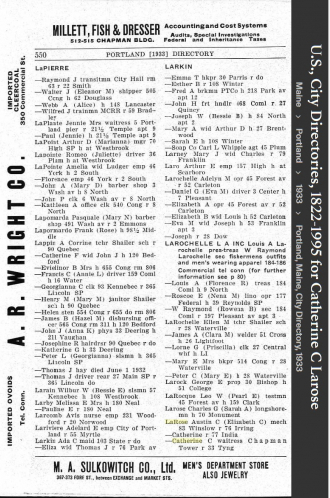
Name Catherine C Larose
Residence Year 1933
Residence Place Portland, Maine, USA
Occupation Waitress
Publication Title Portland, Maine, City Directory, 1933


Maiden Name LaRose
Gender Female
Birth Date 17 Jan 1912
Birth Place Portland, Cumberland County, Maine, United States of America
Death Date 6 Dec 1984
Death Place Portland, Cumberland County, Maine, United States of America
Cemetery Pine Grove Cemetery
Burial or Cremation Place Falmouth, Cumberland County, Maine, United States of America
Has Bio? N
Father Francis Joseph LaRose
Mother Margaret A. LaRose
Spouse Oscar Lawrence Fredriksen
Children Dorothy Jean Fredriksen; Donald Francis Fredriksen

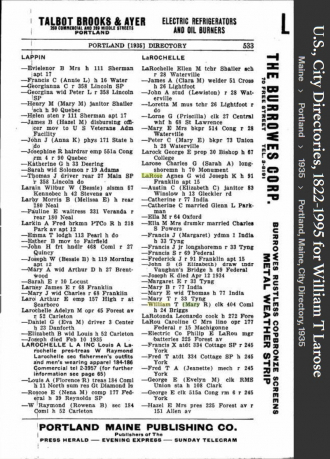
Name William T Larose
Gender Male
Residence Year 1935
Street Address 24 Briggs
Residence Place Portland, Maine, USA
Occupation Clerk
Spouse Mary R Larose
Publication Title Portland, Maine, City Directory, 1935

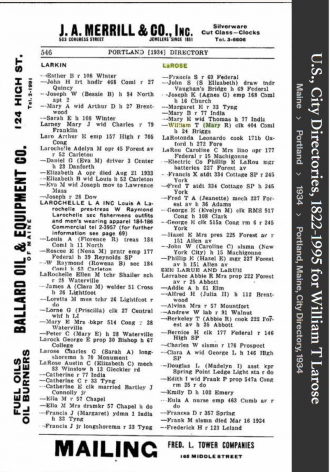
Name William T Larose
Gender Male
Residence Year 1934
Street Address 24 Briggs
Residence Place Portland, Maine, USA
Occupation Clerk
Spouse Mary R Larose
Publication Title Portland, Maine, City Directory, 1934

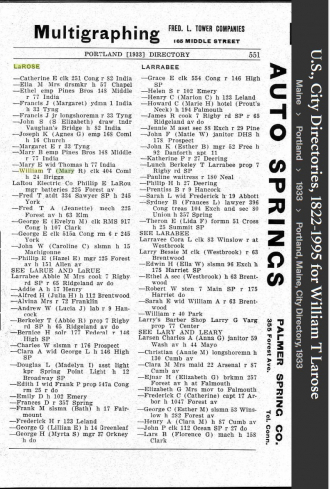
Name William T Larose
Gender Male
Residence Year 1933
Street Address 24 Briggs
Residence Place Portland, Maine, USA
Occupation Clerk
Spouse Mary R Larose
Publication Title Portland, Maine, City Directory, 1933

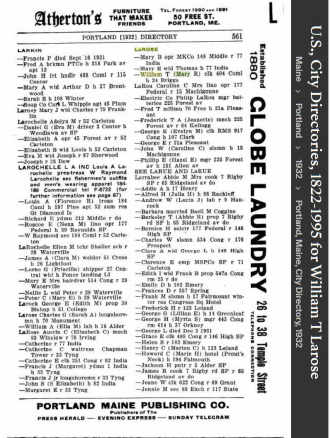
Name William T Larose
Gender Male
Residence Year 1932
Street Address 24 Briggs
Residence Place Portland, Maine, USA
Occupation Clerk
Spouse Mary R Larose
Publication Title Portland, Maine, City Directory, 1932

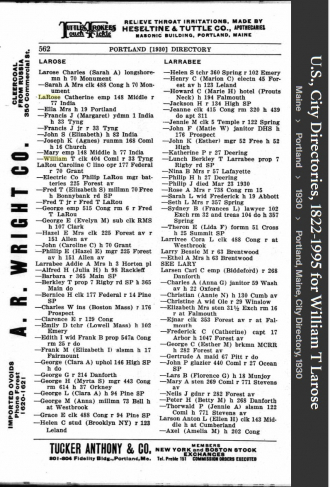
Name William T Larose
Residence Year 1930
Street Address 33 Tyng
Residence Place Portland, Maine, USA
Occupation Clerk
Publication Title Portland, Maine, City Directory, 1930

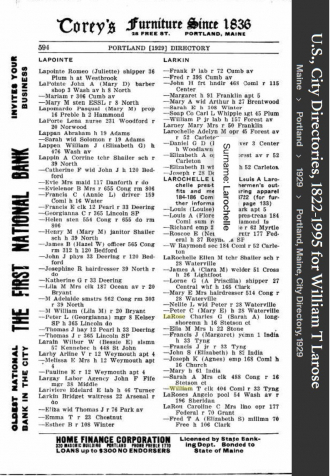
Name William T Larose
Residence Year 1929
Street Address 33 Tyng
Residence Place Portland, Maine, USA
Occupation Clerk
Publication Title Portland, Maine, City Directory, 1929

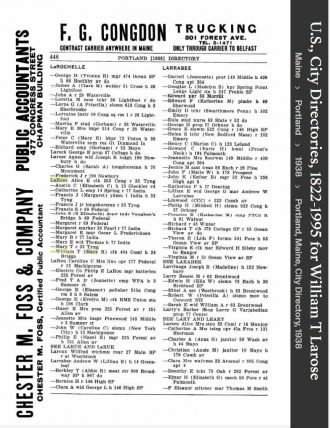
Name William T Larose
Gender Male
Residence Year 1938
Street Address H 24
Residence Place Portland, Maine, USA
Occupation Clerk
Spouse Mary R Larose
Publication Title Portland, Maine, City Directory, 1938

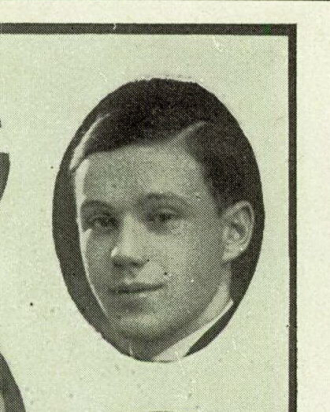
Name William T LaRose
Estimated Age 16
Birth Year abt 1911
Yearbook Date 1927
School Cheverus High School
School Location Portland, Maine, USA

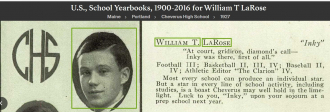
Name William T LaRose
Estimated Age 16
Birth Year abt 1911
Yearbook Date 1927
School Cheverus High School
School Location Portland, Maine, USA

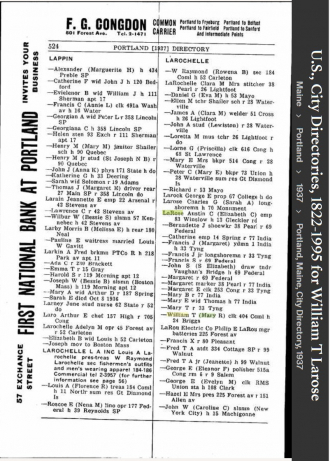
Name William T Larose
Gender Male
Residence Year 1937
Street Address Briggs
Residence Place Portland, Maine, USA
Occupation Clerk
Spouse Mary R Larose
Publication Title Portland, Maine, City Directory, 1937


Name William Thomas LaRose
Birth Date 8 Nov 1909
Birth Place Portland, Cumberland County, Maine, United States of America
Death Date 30 Sep 1965
Death Place Newton, Middlesex County, Massachusetts, United States of America
Cemetery Calvary Cemetery
Burial or Cremation Place South Portland, Cumberland County, Maine, United States of America
Has Bio? N
Father Francis Joseph LaRose
Mother Margaret A. LaRose
Spouse Mary LaRose


Name William Thomas LaRose
Birth Date 8 Nov 1909
Birth Place Portland, Cumberland County, Maine, United States of America
Death Date 30 Sep 1965
Death Place Newton, Middlesex County, Massachusetts, United States of America
Cemetery Calvary Cemetery
Burial or Cremation Place South Portland, Cumberland County, Maine, United States of America
Has Bio? N
Father Francis Joseph LaRose
Mother Margaret A. LaRose
Spouse Mary LaRose

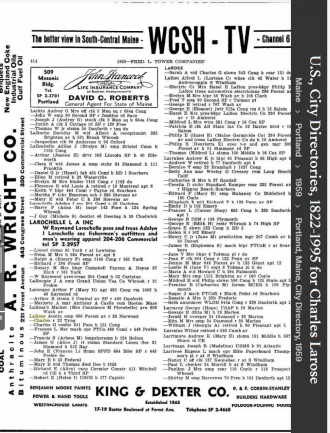
Name Charles Larose
Residence Year 1959
Street Address 33 Tyng
Residence Place Portland, Maine, USA
Publication Title Portland, Maine, City Directory, 1959

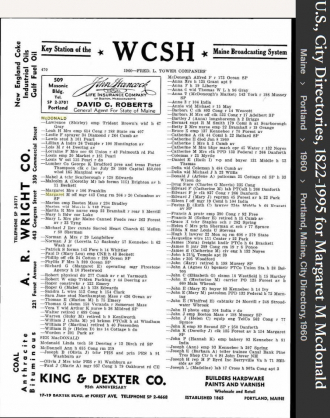
Name Margaret M Mcdonald
Residence Year 1960
Street Address 20 Columbus av
Residence Place Portland, Maine, USA
Occupation Off Mgr
Publication Title Portland, Maine, City Directory, 1960

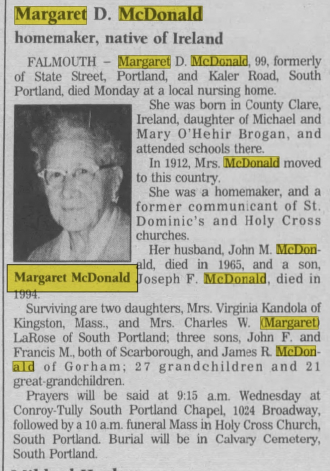
9 JANUARY 1995 • Falmouth, Cumberland, Maine, USA
Larose Family Tree
Discover the most common names, oldest records and life expectancy of people with the last name Larose.
Updated Larose Biographies





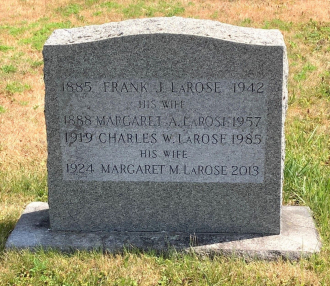



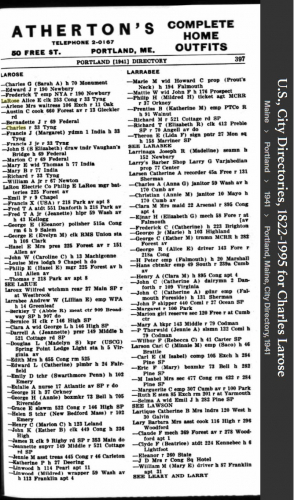





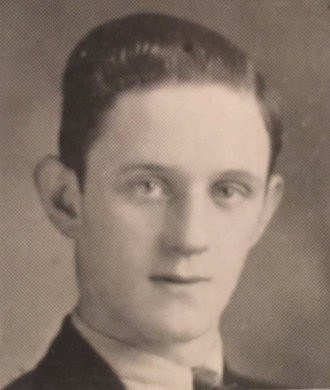

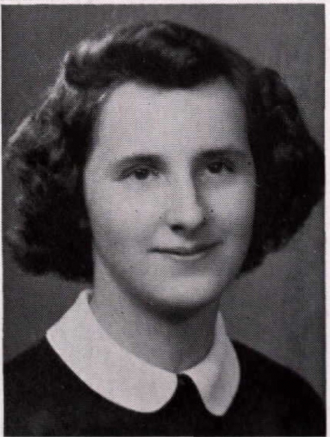


Popular Larose Biographies

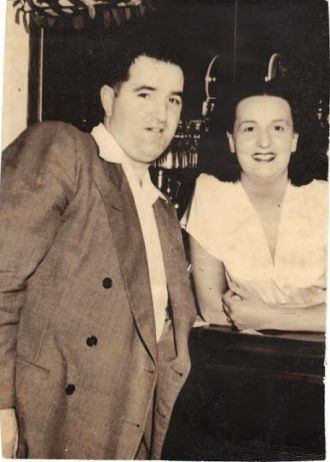








Larose Death Records & Life Expectancy
The average age of a Larose family member is 71.0 years old according to our database of 2,236 people with the last name Larose that have a birth and death date listed.
Life Expectancy
Oldest Laroses
These are the longest-lived members of the Larose family on AncientFaces.
Other Larose Records
Share memories about your Larose family
Leave comments and ask questions related to the Larose family.
Putnam, Connecticut. Theresa (LaRose) Fronczek sat on the knee of her great Uncle listing to the tales of his travels and ventures of the California Gold Rush left a lasting impression on he. She looked up and saw a old man with a weather face and long white hair hanging down his back amaze at the stories he told her. These stories were passed on to me of what she could remember and of what I could remember. Unfortunately her stories related to this paragraph and a few other bits and pieces that I have remember over the years. His legacy from my memory is that he left Putnam for the California Gold Rush one would assume sometime shortly after 1849 when the migration began in the spring and found out that digging for gold was too hard work. He then started a Wild West Saloon in gold country offering whiskey and women of the evening to his clients. Through research the following is an account of what he might have told Theresa woven into her stories.
Newspapers across the county were filled with the stories of men who claimed to have become rich overnight by picking gold out of California’s Sacramento Valley wondrous earth during the summer of 1848. President James K. Polk sent a message to Congress in December confirmed the presence of gold in California. That winter, people from all walks of life set out for California pawing their possessions for stake money.
My great-great uncle LaRose was one of the forty-niners who departed Connecticut seeking his gold riches in California. One could imagine that he read one of many advertisements announcing a “Pioneer Passenger Train for California Overland by the South Pass”. Passage on a wagon train departing Independence, Missouri, using covered, elliptic-spring wagons, each seating six persons. The fares would be $200 and include one hundred pounds of baggage per person and rations for one hundred days. Or he might have read one of the many California guide books that the publishers were scrambling to print from St Lousi to the east coast. Information in the books was taken from dated government reports and the travels of earlier explores and other sources. Data in the books was nor very reliable.
Since the LaRose’s were entrepreneur and adventures, we could assume that he joined the first group of gold seekers led by Captain G.W. Paul of St. Louis on April 15, 1849. The party was made up of ten Missourians and easterners, plus a party from Upper Sandusky, Ohio. The party was the first to cross the Missouri River after the ice broke up in late March and allowed steamboat travel to resume. The party had to stop fifty miles beyond the Kansas River crossing because the spring grasses were not sufficient to feed the oxen.
I can recall my mother Theresa (LaRose) Fronczek saying that her uncle LaRose traveled to California making his way to Independence, Missouri where the Oregon Trail started. One would assume he was one of the thousand pioneers heading for the 2,000 mile Oregon Trail. The well traveled worn 2,000 mile long Oregon Trail to California through the Great Plains using either the Oregon or Mormon trail. By 1852, he was one of the 200,000 gold seekers who had managed to reach California one way or another. Travel was slow averaging around 3 miles per hour by wagon. He either traveled by oxen pulled wagon, horse, mule or walked. The oxen was the prefer animal to use because it was sure-footed, calm, less apt to be scared or to flounder in the mud or snow. Oxen cost less than a horse to purchase and maintain. Oxen could be maintained on a coarse diet of prairie grass and sage while a horse could not and had to be fed. Mules could make better speed than the horse or oxen, but did hot have the staying power of oxen. Since he was single, we could assume that he traveled on a cantankerous disposition mule. The journey took him about four and half months. A typical day’s travel was around twenty miles a day, stopping around midday to allow time for the animals to graze before bringing them into the camp area for the night. Evening meal was usually fried bacon and dough fried in the fat, with tea or coffee when fresh game was not available. There ware many who had perished along the way from chorea, illness or accident.
Upon reaching California, Uncle LaRose tried his hand at panning for gold and quickly decided that panning and digging was too hard. Since the LaRose’s are of the enterpreur sprit, Uncle LaRose determined his fortune could be made in operating one of the oldest professions, gambling and ladies of the evening. With this idea, Uncle LaRose found the financing to erect a haphazard canvas tent around 1849 or later most likely located in Old Hangtown now know as Placerville or he was in one of the other Sierra Mountain mining towns of Whiskey Bar, Jackass Gulch, Poker Flat, or Flapjack Canyon.. Each one of these frontier mining settlements were know to have salons of some sort within a year or so after gold was discovered. The majority of these towns sprang up over night and then quickly disappeared when the gold ran out.
By 1854, Old Hangtown was the third largest city in California with a population of 5,000 shop keepers, forty-niners and others. “Placer mining-picks, shovels, pans and sluice boxes coaxed about $1 million in gold from the streams around Old Handtown by 1852” says Rich Dvoracek, a local geologists and volunteer at the Gold Bug Park and Mine. It is estimated there was about 143 gold mines operating in and around Old Hangtown during the peak of the Gold Rush, from 1850 to 1851. “Figures run as high as $25 million for the value of gold that ultimately come out of Old Hangtown mines from the mid-1850’s to the mid-1870’s when hard rock quartz mining took over. This is where my great-great uncle LaRose made his fortune running a saloon with ladies of the evening according to my mother..
By 1851 gold became organized big business using the latest mining technology. These new large Eastern finance businesses began to replace the improvised group efforts of the forty-niners with professional miners and equipment. The majority of forty-niners remained in California too embarrassed to return home without riches, many of them returned to the occupations they held before their quest for gold in California. Except for my uncle, who returned to Putnam a wealth man on the newly completed transcontinental railroad sometime after 1869? My mother Theresa (LaRose) Fronczek remembers sitting on his lap of a very old mostly likely in the 80’s or older LaRose with long flowing white hair and beard telling her tales of his adventures in California He was quite a talker according to Theresa.
Written by Paul Fronczek based famly lore from his mother Theresa A. (LaRose) and historical research.
Followers & Sources

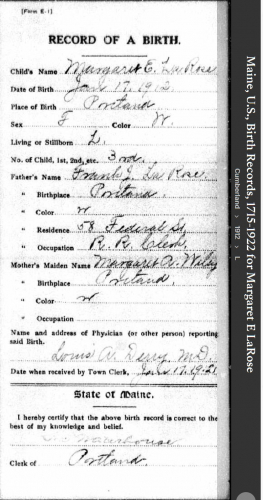
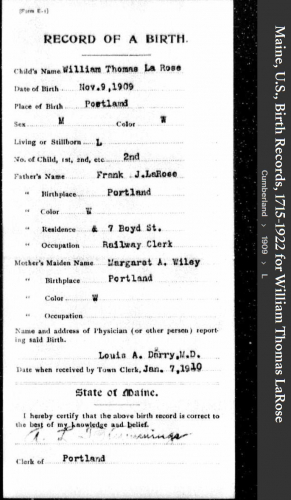
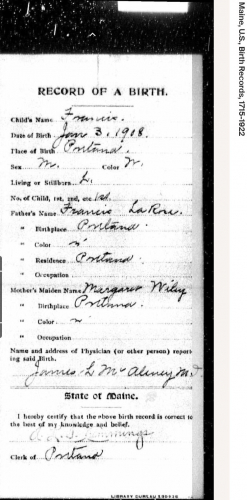
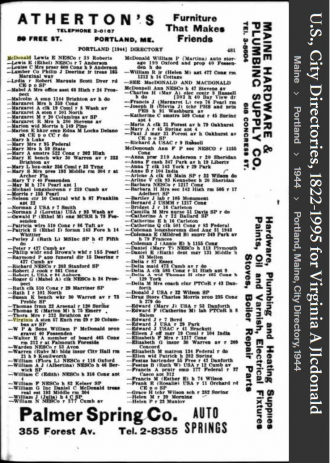

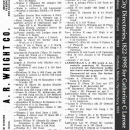
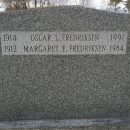
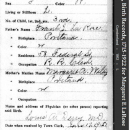
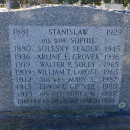

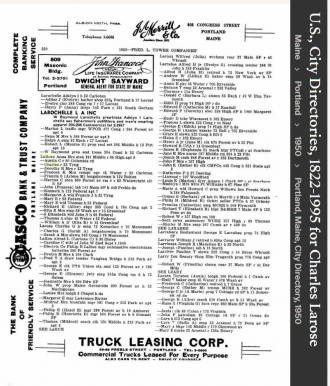
Prohibition was a turbulent time in United States history, a time when the bootlegger, the “speakeasy” and the gangster became popular institutions throughout America, especially in the east. During prohibition it was illegal to manufacture, sell or consume alcohol. Organized crime flourished corrupting almost every level of government. There was money to be made in the sale, manufacturing, transporting of alcohol and its related industries. The LaRose brothers were no exception as they expanded their trucking company to transport Canadian alcohol to the thirsty American market, even if it was illegal.
One could assume the LaRose brother’s ties with relatives in Canada enhance their new lucrative opportunity of transporting whiskey to the United States. Joseph Edward LaRose house in Putnam, Connecticut was used by his brothers as a as rest stop during their arduous journeys.
According to Theresa daughter of Joseph Edward LaRose the big black canvas covered trucks loaded with whiskey would back into the narrow driveway along the house for the night. After a hardy meals prepared by my grandmother Alphonsine, Joseph brothers would retire in the parlor for a much needed rest. Joseph guarded the trucks sitting in his rocker with a shotgun across his lap. My grandmother, Alphonsine and her children, Theresa and Dorothy usually stayed up all night with Joseph watching and afraid to sleep while Joseph brothers slept soundly in the parlor. Sunrise was a welcoming sight as the trucks rolled out of the driveway, their illegal cargo destination unknown. It wasn’t until the end of Prohibition in 1933, that Edward was able to put his shotgun away and the all night vigils ended.
Written by Paul Fronczek grandson of Edward LaRose based on narrative stories from his mother Theresa,